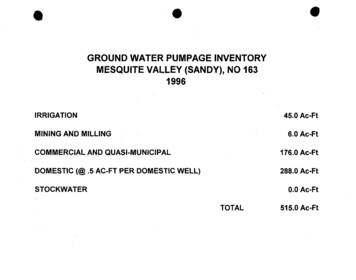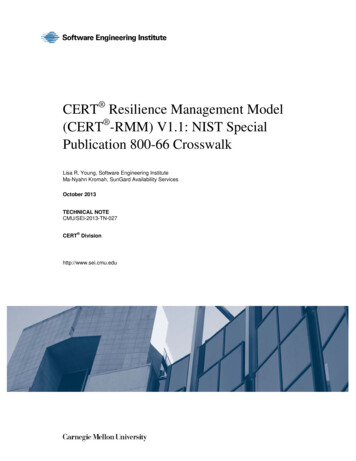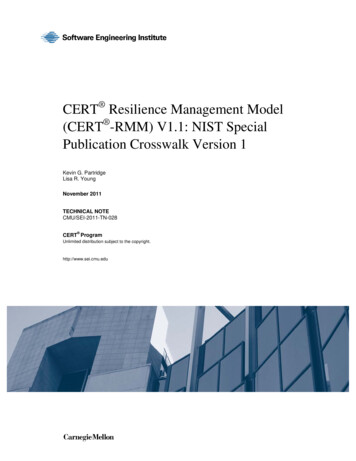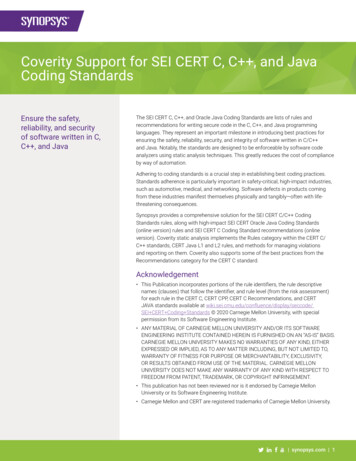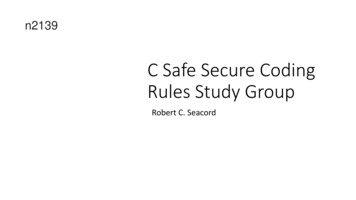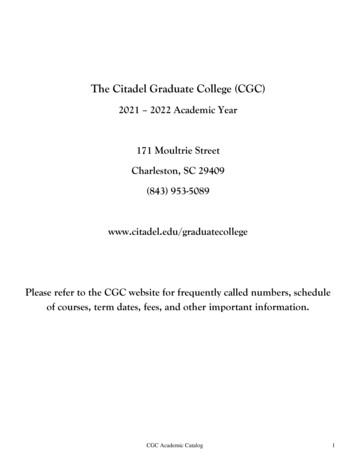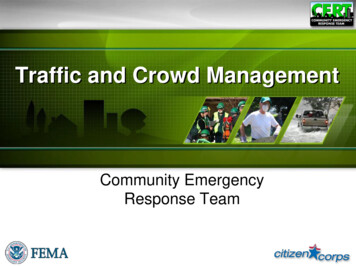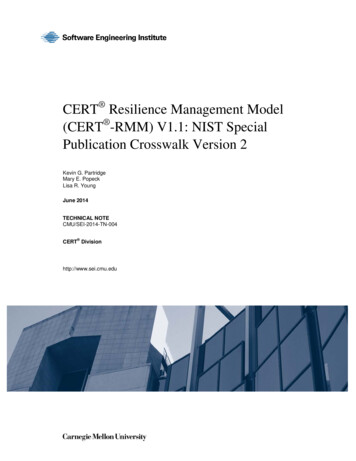
Transcription
Report from the First CERT-RMMUsers Group Workshop SeriesJulia H. AllenLisa YoungApril 2012TECHNICAL NOTECMU/SEI-2012-TN-008CERT Programhttp://www.sei.cmu.edu
Copyright 2012 Carnegie Mellon University.This material is based upon work funded and supported by the United States Department of Defense under Contract No.FA8721-05-C-0003 with Carnegie Mellon University for the operation of the Software Engineering Institute, a federallyfunded research and development center.Any opinions, findings and conclusions or recommendations expressed in this material are those of the author(s) and donot necessarily reflect the views of the United States Department of Defense.This report was prepared for theContracting OfficerESC/CAA20 Shilling CircleBuilding 1305, 3rd FloorHanscom AFB, MA 01731-2125NO WARRANTYTHIS CARNEGIE MELLON UNIVERSITY AND SOFTWARE ENGINEERING INSTITUTE MATERIAL ISFURNISHED ON AN “AS-IS” BASIS. CARNEGIE MELLON UNIVERSITY MAKES NO WARRANTIES OF ANYKIND, EITHER EXPRESSED OR IMPLIED, AS TO ANY MATTER INCLUDING, BUT NOT LIMITED TO,WARRANTY OF FITNESS FOR PURPOSE OR MERCHANTABILITY, EXCLUSIVITY, OR RESULTSOBTAINED FROM USE OF THE MATERIAL. CARNEGIE MELLON UNIVERSITY DOES NOT MAKE ANYWARRANTY OF ANY KIND WITH RESPECT TO FREEDOM FROM PATENT, TRADEMARK, OR COPYRIGHTINFRINGEMENT.This material has been approved for public release and unlimited distribution except as restricted below.Internal use:* Permission to reproduce this material and to prepare derivative works from this material for internal use isgranted, provided the copyright and “No Warranty” statements are included with all reproductions and derivative works.External use:* This material may be reproduced in its entirety, without modification, and freely distributed in written orelectronic form without requesting formal permission. Permission is required for any other external and/or commercialuse. Requests for permission should be directed to the Software Engineering Institute at permission@sei.cmu.edu. CERT is a registered trademark owned by Carnegie Mellon University. Capability Maturity Modeling and CMMI are registered in the U.S. Patent and Trademark Office by CarnegieMellon University.SMIDEAL is a service mark of Carnegie Mellon University.*These restrictions do not apply to U.S. government entities.SEI markings v3.2 / 30 August 2011
Table of .1 Purpose1.2 Structure of This Report1112Overview of the RUG Workshop Series and CERT-RMM2.1 Overview of the First CERT-RMM Users Group (RUG) Workshop Series2.2 Overview of CERT-RMM2223Architecture of the First RUG Workshop Series3.1 Background3.2 Advance Preparation5554Workshop 1: Planning4.1 Advance Preparation4.2 Topics4.3 Outcomes4.4 Preparation for Workshop 2777895Workshop 2: Improvement Objective5.1 Advance Preparation5.2 Topics5.3 Outcomes5.4 Preparation for Workshop 310101011126Workshop 3: Diagnosis6.1 Advance Preparation6.2 Topics6.3 Outcomes6.4 Preparation for Workshop 413131315157Workshop 4: Improvement Progress7.1 Advance Preparation7.2 Topics7.3 Outcomes161616198Improvements for Future RUG Workshop Series8.1 Contact Us2020Appendix: 2012 SEPG North America RUG Panel Slides21References35CMU/SEI-2012-TN-008 i
CMU/SEI-2012-TN-008 ii
List of FiguresFigure 1:CERT-RMM Context4Figure 2:The SEI IDEAL Model [McFeeley 1996]9Figure 3:CERT-RMM Improvement-Project Lifecycle11CMU/SEI-2012-TN-008 iii
CMU/SEI-2012-TN-008 iv
List of TablesTable 1:Preparatory Questions5Table 2:Workshop 1 Topics7Table 3:Workshop 2 Topics10Table 4:Workshop 3 Topics13Table 5:Workshop 4 Topics16CMU/SEI-2012-TN-008 v
CMU/SEI-2012-TN-008 vi
AcknowledgmentsThe authors would like to acknowledge and thank the members of the first CERT ResilienceManagement Model (RMM) Users Group (RUG), for their active participation, candor, hardwork, and contributions to CERT-RMM implementation. We greatly appreciate their willingnessto be innovators and early adopters of this workshop series and their substantial improvementsuggestions, which will greatly benefit future RUG members. Mary Ann Blair, Doug Markiewicz, and Chris OrtylCarnegie Mellon University Information Security Office Kent Anderson, Margaret Munk, and Ric RobinsonDiscover Financial Services Lynn Penn and Dorna WitkowskiLockheed Martin Information Systems & Global Solutions Todd Bame, Eric Brown, Greg Crabb, Aubrey Surgers, and Jim WilsonUnited States Postal Inspection ServiceThe authors would like to thank William David, Lockheed Martin Enterprise Business Services,for sharing his organization’s experiences in its use of CERT-RMM. We would also like to thankNader Mehravari, formerly with Lockheed Martin Enterprise Business Services, for attendingWorkshop 2 and advising RUG development team members.The authors would like to thank our SEI colleagues who graciously gave their time to informRUG members of their work as part of our workshop lunch presentations: Anne Connell, RitaCreel, Rich Friedberg, Joji Montelibano, Greg Shannon, and David White.The authors would like to thank our SEI colleagues, all of whom were instrumental in the conductand success of this users group workshop: Rick Barbour, Rita Briston, Matt Butkovic, Jim Cebula, Pamela Curtis, Linda Parker Gates, Lora Gress, Barbara Tyson, David Ulicne, Jeff Welch, David White, and Katie Palermo Worthy.Last, but certainly not least, the authors would like to thank Rich Caralli for his thought leadershipand sponsorship of this users group workshop. CERT is a registered trademark owned by Carnegie Mellon University.CMU/SEI-2012-TN-008 vii
CMU/SEI-2012-TN-008 viii
AbstractThis report describes the first CERT Resilience Management Model (RMM) Users Group(RUG) Workshop Series and relays the experiences of participating members and CERT staff.This workshop series comprised four workshops, which took place between March 2011 and February 2012. In this report, we provide a brief overview of the CERT Resilience ManagementModel (CERT-RMM), describe the architecture for this series of workshops, and present suggestions for improving future RUG Workshop Series.CMU/SEI-2012-TN-008 ix
CMU/SEI-2012-TN-008 x
1 Introduction1.1PurposeThe purpose of this report is to describe the first CERT Resilience Management Model (RMM)Users Group (RUG) Workshop Series and relay experiences of members who participated in itand CERT staff who conducted it. The RUG workshop was originally conceived as a means tohelp CERT Resilience Management Model (CERT-RMM) users progress in their adoption of themodel and get practice using it after taking the three-day Introduction to CERT-RMM course. Theworkshop was also intended to 1) help CERT staff members understand the requirements necessary to implement CERT-RMM and 2) develop materials that would help users put CERT-RMMpractices into action on their specific improvement projects.1.2Structure of This ReportSection 2 provides a brief overview of first CERT-RMM Users Group Workshop Series andCERT-RMM.Section 3 provides background about the first RUG Workshop Series and the steps RUG memberstook during the preparatory phases.Sections 4 7 outline the preparation, topics, results, and next steps for the four workshops thatconstituted the first RUG Workshop Series; these workshops were held March 2011, May 2011,August 2011, and January/February 2012.Section 8 lists suggestions for improving future RUG workshops.The appendix includes the RUG panel presentation given at the Software Engineering Institute’s(SEI’s) 2012 Software Engineering Process Group Conference, North America. The presentationincludes slides provided by four of the five RUG member organization. CERT is a registered trademark owned by Carnegie Mellon University.CMU/SEI-2012-TN-008 1
2 Overview of the RUG Workshop Series and CERT-RMM2.1Overview of the First CERT-RMM Users Group (RUG) Workshop SeriesThe purpose of the first RUG Workshop Series is to offer RUG members an opportunity to engage in customized collaborative discussions, hands-on activities, and workshop exercises andassignments that help them to implement a solution that meets a specific resilience improvement objective that is tied to anorganizational goal improve the effectiveness and efficiency of operational risk management activities diagnose their current resilience activities against CERT-RMM processes and practices conduct peer-to-peer comparisons and learn from others, including CERT-RMM developersand lead appraisers define processes and identify measures to evaluate and improve resilience learn how to reduce the complexity and improve the efficiency of compliance and other assessment-related activities learn more about current CERT work from guest speakersThe RUG Workshop Series comprised four workshops, which took place between March 2011and February 2012. RUG members were interviewed in advance of the first workshop so that theRUG Development Team (RDT) could better understand their objectives and requirements anduse these to shape the RUG Workshop Series.1 In addition, between workshops, the RDT heldperiodic conference calls to discuss issues and ongoing preparatory assignments.Members of the first RUG Workshop Series included the Information Security Office from Carnegie Mellon University (CMU), representing academia; Discover Financial Services (DFS), representing the commercial financial sector; Lockheed Martin Information Systems & Global Solutions (IS&GS), representing the U. S. defense industrial base; and the United States PostalInspection Service (USPIS), representing government.Members benefited by having access to such a diverse set of organizations that represented several of the market sectors to which CERT-RMM applies. This organizational diversity was oftencited by members and CERT staff as one of the key benefits of the first RUG Workshop Series.2.2Overview of CERT-RMMCERT-RMM is a capability-focused maturity model for process improvement that reflects bestpractices from industry and government for managing operational resilience across the domains of1The RDT consists of CERT staff members who support the RUG Workshop Series.CMU/SEI-2012-TN-008 2
security management, business continuity management, and aspects of information technology(IT) operations management.2 CERT-RMM defines operational resilience asthe emergent property of an organization that can continue to carry out its mission in thepresence of operational stress and disruption that does not exceed its limitThrough CERT-RMM, these best practices are integrated into a single model that provides anorganization with a transformative path from a silo-driven approach for managing operational riskto one that is focused on achieving resilience management goals and supporting the organization’sstrategic direction [Caralli 2011].CERT-RMM incorporates many proven concepts and approaches from the SEI’s process improvement experience in software and systems engineering, service engineering, and acquisition.Foundational concepts from Capability Maturity Model Integration (CMMI ) are integrated intoCERT-RMM to elevate operational resilience management to a process approach and provide anevolutionary path for improving capability.3 Practices in the model focus on improving the organization’s management of key operational resilience processes. This improvement enables highvalue services to meet their mission consistently and with high quality, particularly during timesof stress and disruption [Caralli 2011].CERT-RMM helps to ensure that the organization’s important assets—people, information, technology, and facilities—effectively support business activities and services. The model serves as afoundation from which an organization can measure its current competency, set improvement targets, and establish plans and actions to close any identified gaps. As a result, the organization repositions and repurposes its security, business continuity, and IT operations activities and adopts aprocess improvement mindset that helps to keep services and assets productive in the long term[RUG 2011].The context for CERT-RMM is shown in Figure 1.2For more information about CERT-RMM, refer to the book titled CERT Resilience Management Model: A Maturity Model for Managing Operational Resilience and the CERT Resilience Management Model pages on theSEI website [Caralli 2011, RMM 2012]. Capability Maturity Model and CMMI are registered in the U.S. Patent and Trademark Office by CarnegieMellon University.3For more information about CMMI, refer to the CMMI pages on the SEI website [SEI 2012a].CMU/SEI-2012-TN-008 3
Figure 1: CERT-RMM ContextCMU/SEI-2012-TN-008 4
3 Architecture of the First RUG Workshop Series3.1BackgroundThe RDT developed an initial architecture that described the intent of each segment of the firstRUG Workshop Series. The architecture provided prospective members with an idea of what wasto come and provided RDT staff with a roadmap to follow as the series progressed. The architecture was reviewed by members and updated in advance of each individual workshop.We summarize the first RUG Workshop Series architecture, as it evolved, in the following sections. The architecture describes advance preparation for the entire workshop series and for eachindividual workshop, topics to be covered in sequential order, takeaways, outcomes, and expectedpreparation for each subsequent workshop.As a result of conducting the first RUG Workshop Series, we developed an improved architecture,which we will use to guide future workshops. We summarize key improvements in Section 8 ofthis report.3.2Advance PreparationRepresentatives from all member organizations were interviewed in advance of the first RUGWorkshop Series. These interviews occurred from October 2010 to the start of Workshop 2 inMay 2011, when the CMU team joined the effort. As part of each member interview, the RDTasked the questions that are listed in Table 1.Table 1:1.Preparatory QuestionsWhy are you interested in CERT-RMM?a.Are you actively using CERT-RMM in your organization? If so, how? If not, do you plan to useit?b.Is your use of or interest in CERT-RMM most related to 1) business continuity, 2) security, 3)IT operations, 4) operational risk and resilience management in general, or 5) all of these?c.Are you interested in specific process areas (PAs)? If so, which ones?2.What are your top three expectations and desired outcomes for the first RUG Workshop Series andfor the RUG Workshop Series in general?3.Are you interested in becoming a CERT-RMM lead appraiser or instructor? If so, in what time frame?4.We would like to use resilience measurement challenges, objectives, and example measures fromparticipants in discussions and as examples in the workshop series. Would you or your organizationbe willing to openly share such experiences and examples with other workshop series members?5.Is there anything else that you would like to share regarding your participation in the CERT-RMMUsers Group?CMU/SEI-2012-TN-008 5
We also required that members complete the Introduction to CERT-RMM course become familiar with CERT-RMM publications, webinars, podcasts, and the book CERT Resilience Management Model: A Maturity Model for Managing Operational Resilience [Caralli2011], which describes CERT-RMM Version 1.1 prepare a 15-20 minute presentation that addresses the following questions: What are you doing today about resilience?What are your top three to five issues and uncertainties in your current resilience practices?What measures do you use to manage resilience?The RDT analyzed and synthesized interview data and determined that this particular group ofmembers would be most interested in participating in a workshop that focuses on CERT-RMMmodel implementation and improvement, which involves leading RUG members through aCERT-RMM-based improvement cycle using member-declared improvement objectives that meetorganizational goals.At this point in the preparatory phase, none of the member organizations were interested in pursuing lead appraiser or instructor certification. Because of this, the RDT did not include this topic inthe RUG Workshop Series. We subsequently learned that some members of the CMU and Lockheed Martin (LM) teams did have such interests; therefore, we took follow-up action to remedythis after Workshop 4.CMU/SEI-2012-TN-008 6
4 Workshop 1: PlanningRUG members from the DFS, LM, the USPIS, and the CERT RDT attended this workshop, whichwas held March 15-16, 2011 in Pittsburgh, PA. The CMU team did not join this workshop seriesuntil Workshop 2.4.1Advance PreparationIn preparation for Workshop 1, we asked members to prepare slides that provide a brief introduction of themselves, their organization, their current resilience activities (if any), and the top threeto five resilience concerns and issues.We also asked members to think about improvement objectives that could be implemented in aproject lasting 10-12-months. Members came to Workshop 1 prepared to discuss a small numberof improvement objectives that they wished to declare and the rationale for each objective. We setexpectations with members so they understood that the improvement objectives were to be business oriented and operational in nature, not specific to CERT-RMM.4.2TopicsTable 2 lists the topics that we presented and discussed during Workshop 1.Table 2:Workshop 1 TopicsWorkshop 1 Topics first RUG Workshop Series initial architecture and plan member organization (initially DFS, LM, and the USPIS) presentations including an organizational overview,objectives for the first RUG Workshop Series, and initial improvement-project objectives a presentation by LM Enterprise Business Resilience Services that described the company’s initial experiencesin selecting CERT-RMM as its improvement model of choice conducting CERT-RMM appraisals for improving corporate-wide business continuity, IT disaster recovery,crisis management, and pandemic-planning activities a presentation template for gaining senior-management sponsorship organizational scoping, applied to each member’s improvement objective CERT-RMM model scoping, applied to each member’s improvement objective an overview of the CERT Insider Threat Project4 member feedback about Workshop 1Prior to the workshop, members had selected candidate improvement objectives based on a rangeof factors including the following: respond more effectively to high-profile, high-impact incidents work more effectively with supply chain partners4For more information about the CERT Insider Threat Project, visit the CERT website(http://www.cert.org/insider threat).CMU/SEI-2012-TN-008 7
satisfy specific compliance requirements more effectively integrate aspects of CERT-RMM with current standards and process models address directives from senior executivesThroughout this workshop series, we regularly discussed the definition of operational resilience(presented in Section 2). We also discussed topics related to deriving specific interpretations ofoperational resilience for information security, business continuity, IT operations, and software/system development each member’s specific business. We asked ourselves, “What does operational resiliencemean to us and our ability to fulfill our mission and meet business objectives?”Ongoing interpretation and tailoring of the intent of CERT-RMM as applied to each member organization’s improvement project occurred throughout the first RUG Workshop Series.For organizational and model scoping, discussions included fine-grained scoping options based onCERT-RMM processes and practices of interest, the selected organizational unit(s) that will benefit from the improvement, the differences between CERT-RMM and CMMI (for those organizations that have already adopted it), and other caveats. Discussions also included whether the scopeshould be at the process area (PA) level or the practice level. Members were encouraged to choosetheir scoping granularity based on their process-improvement objectives. To facilitate this process, the RDT distributed a spreadsheet that could be used for CERT-RMM model scoping.Workshop members spent considerable time honing their respective improvement objectives.4.3OutcomesTakeaways and outcomes from Workshop 1 included the following: considerations for refining improvement objectives a method for determining CERT-RMM model and organizational scope based on improvement objectives a method for diagnosis based on CERT-RMM Compass, a self-administered survey questionnaire composition of a CERT-RMM improvement plan and approach based on the SEI IDEALSMmethod (See Figure 2.) a brief description of CERT-RMM licensed roles and the certification process confirmation of dates for successive workshops based on a fuller understanding of the work that needs to be conducted between workshops a desire to accelerate improvement-project implementation refinements to the RUG architecture and planbeneficial insights from information-sharing sessions and feedback SMIDEAL is a service mark of Carnegie Mellon University.CMU/SEI-2012-TN-008 8
An organizational improvement model thatserves as a roadmap forinitiating, planning, andimplementingimprovement actionsProvides a structure fororganizations to planand implement aprocess improvementprogramFigure 2: The SEI IDEAL Model [McFeeley 1996]4.4Preparation for Workshop 2In preparation for Workshop 2, members defined and refined improvement objective(s), including providing rationale for selection (one or two slides) a list of the objectives that were considered and rejected with rationale described the organizational scope (one or two slides, including an illustration of the scope ona member organizational chart) depicted the CERT-RMM model scope by process area and practice (We provided an Excelspreadsheet to members.) developed a sponsor presentation (i.e., a plan to garner support for the improvement projectfrom the project sponsor)CMU/SEI-2012-TN-008 9
5 Workshop 2: Improvement ObjectiveRUG members from the CMU, DFS, LM, and USPIS project teams attended this workshop,which was held May 10-11, 2011 in Pittsburgh, PA. Between Workshops 1 and 2, the RDT decided that the first RUG Workshop Series represented an excellent opportunity to identify a CERTimprovement objective and have a CERT team participate in the RUG in the same fashion as theother member teams. Thus the CERT Resilience Enterprise Management (REM) Team also attended and presented at Workshop 2.5.1Advance PreparationIn preparation for Workshop 2, members completed the assignments described in Section 4.4 ofthis report.5.2TopicsTable 3 lists the topics that we presented and discussed during Workshop 2.Table 3:Workshop 2 TopicsWorkshop 2 Topics member organization (CMU, DFS, LM, USPIS, and CERT REM) presentations including an updated improvement-project objective, organizational scope, model scope, and sponsor presentationproject-improvement method/lifecycle based on the SEI’s IDEAL model, as modified for CERT-RMM5 (SeeFigure 3.)organizational and model improvement scope, and whether the intent of the diagnosis is to evaluate an intent toimprove (as described in policies and plans) or the actual implementationthe distinctions between SCAMPI class A, B, and C appraisals and CERT-RMM Compass6, 7the types of evidence that are collected and reviewed during diagnosis/appraisal, their distinctions (e.g., allpolicy artifacts, all affirmations, or all implementation artifacts), and the value of using a consistent body of evidencevarious approaches for data collection and diagnosis of the organization’s current state based on the improvement objective, organizational scope, and model scope sharing of member experiences the benefit of surveying people as a group to improve the fidelity of answers the opportunity for participants to interactthe value of having defined processes in place as described in the Organizational Process Definition (OPD) andOrganizational Process Focus (OPF) PAs and the value of having a process asset librarypreparation of diagnostic findings for Workshop 3team work sessions to apply methods and discussions to their teams’ specific projects and identify modifications to improvement objectives, organizational scope, and model scopean overview of the CERT research program and future plansan overview of the CERT Digital Intelligence and Investigation Directorate (DIID) forensics work8member feedback about Workshop 25One member expressed a preference for using Six Sigma’s DMIAC (Design, Measure, Analyze, Improve, Correct) method instead of IDEAL.6SCAMPI stands for Standard CMMI Appraisal Method for Process Improvement. For more information aboutSCAMPI, see the 2011 handbook titled Standard CMMI Appraisal Method for Process Improvement (SCAMPI)A, Version 1.3: Method Definition Document [SCAMPI 2011].7A Compass survey is closest to a class C but does not require a plan and does not cover the generic goals(GGs) and GPs.8For more information about the work of the CERT DIID, visit the CERT website 08 10
Figure 3: CERT-RMM Improvement-Project LifecycleKey discussion points included CERT-RMM variation of the IDEAL model, since this made moresense to RUG members. During Workshop 2, participants started to tease out key characteristicsof effective and ineffective organizational scope and model scope. For example, workshop members noted that it is important to ensure that the gaps selected for action resulting from a diagnosisare under the control of the sponsor. This will allow organizations to make forward progress unencumbered. In addition, workshop members noted that when organizations are just getting started, it is important to select a narrow model scope—perhaps just a few specific practices (SPs).(This is an example of the proverb “walk before you run.”)When performing a diagnosis, it is important to frame diagnostic questions in language that ismeaningful to participants. Additionally, one member stated that when performing a diagnosis, itis helpful to have a wide range of objectives beyond the stated improvement objective. It is beneficial to ask questions such as Did this approach work? How well did it work? If the approach did not work, how should we handle similar situations in the future?5.3OutcomesTakeaways and outcomes from Workshop 2 included the following: a greater appreciation for the thought and effort required to effectively define organizationalscope and model scope so that you can make forward progress in a reasonable period of time methods and templates for determining practices and gaps in practice to meet improvementobjectives based on the model scope refinements to the organizational scope and model scope based on the planned diagnosis a CERT-RMM improvement plan and approach based on the IDEAL model, as modified forCERT-RMM (See Figure 3.) beneficial insights from information-sharing sessions and feedbackCMU/SEI-2012-TN-008 11
5.4 Preparation for Workshop 3In preparation for Workshop 3, members updated improvement objectives, the organizational scope, and the model scope based onWorkshop 2 discussions and the diagnosis of their current state provided the results of their diagnosis (by practice, across organizational scope) and submitted the results to the RDT two weeks before Workshop 3. We asked members to include thefollowing information: strengths, opportunities, weaknesses, and gaps (local and systemic)feedback on the use of the diagnostic method of choice (Members used either CERTRMM Compass or SCAMPI.) activities required to prepare the organizational team to conduct the diagnosis (e.g.,awareness, training, ability to participate in the diagnostic process) recommendations about diagnostic activities (e.g., what worked well, what did not workwell) prioritized actions resulting from the diagnosis examples of useful artifacts (e.g., processes, checklists, templates, methods, and tools)participated in teleconferences between Workshops 2 and 3 to assist with diagnosis, as needed CMU/SEI-2012-TN-008 12
6 Workshop 3: DiagnosisRUG members from the CMU, DFS, LM, USPIS, and CERT REM project teams attended thisworkshop, which was held August 30-31, 2011 in the SEI, Arlington, VA office.6.1Advance PreparationAdvance preparation for Workshop 3 consisted of completing the assignments described in Section 5.4 of this report.6.2TopicsTable 4 lists the topics that we presented and discussed during Workshop 3.Table 4:Workshop 3 TopicsWorkshop 3 Topics member organization (CMU, DFS, LM, USPIS, and CERT REM) presentations including diagnostic resultsinitial gaps for action planningany updates to improvement-project objective, organizational scope, and model scopelessons learned member estimates of the effort involved in conducting the diagnosis a description of CERT work in process definition and measurement as a key foundation for implementing improved processes and measuring the extent to which they are adding value [Allen 2010, 2011a, & 2011b] criteria for determining when to commit resources to define a process process and procedure definition templates, with examples one member suggested using lean Six Sigma and other techniques to streamline the process one member shared an alternative process definition template and example [Allen 2011b] a measurement template, with examples discussion to brainstorm measures of success for the first RUG Workshop Series an overview of the work of the CERT Network Situational Awareness Team9 an overview of the CERT work in standards-based, automated remediation10 member feedback about Workshop 3Some of the criteria and success factors that members shared for determining when to commitresources to define a process include the following: The process is highly repeatable. The process, while performed infrequently, needs to be completed the same way
CERT-RMM is a capability-focused maturity model for process improvement that reflects best practices from industry and government for managing operational resilience across the domains of 1 The RDT consists of CERT staff members who support the RUG Workshop Series.


